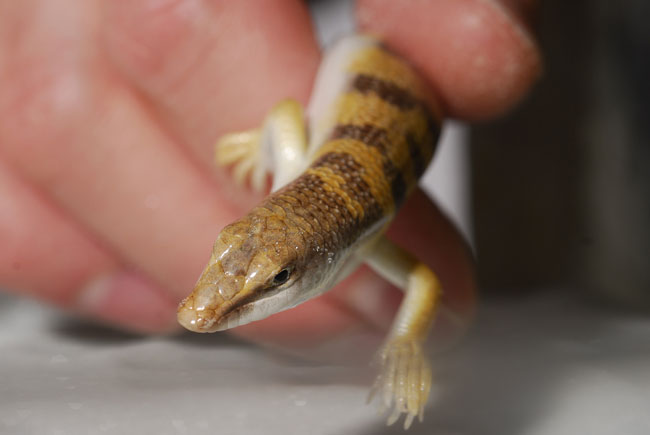Physicist: Studying Lizards Since Age 5

Georgia Tech physicist Daniel Goldman recently helped figure out how sandfish — small lizards with smooth scales — move rapidly underground through desert sand. In this first thorough examination of subsurface sandfish locomotion, he and his colleagues used high-speed X-ray imaging to visualize sandfish, formally called Scincus scincus, burrowing into and through their environment. The team used that information to develop a physics model of the lizard’s locomotion, revealing that the animals place their limbs against their sides and create a wave motion with their bodies to propel themselves through granular media. For video and more about the project, go here, for Goldman’s answers to the ScienceLives 10 Questions, see below.
Name: Daniel I. Goldman Age: 37 Institution: Georgia Institute of Technology Field of Study: Physics (specifically biomechanics, granular media, nonlinear dynamics)
What inspired you to choose this field of study? During my childhood, I was fascinated by lizards and bugs. When I was an undergrad at the Massachusetts Institute of Technology (MIT), I took an introductory physics course based around hands-on experiments. I also did undergraduate research in a laboratory where we built most of our apparatuses. These set the stage for all my subsequent research — table-top scale experiments on granular media and animal locomotion.
What is the best piece of advice you ever received? I met Max Perutz (Nobel Prize-winning biologist) when I was a senior in high school. He told me "Find a good mentor." I have been incredibly fortunate to do so at all stages of my training.
What was your first scientific experiment as a child? I studied how temperature affects the breathing rate of lizards. I found that the hotter it got, the faster they breathed.
What is your favorite thing about being a scientist or researcher? I love being able to do what I've been doing since I was five years old: have the freedom to observe and interrogate nature. Even better, now I get paid to do this.
What is the most important characteristic a scientist must demonstrate in order to be an effective scientist? Two: passion and persistence.
Sign up for the Live Science daily newsletter now
Get the world’s most fascinating discoveries delivered straight to your inbox.
What are the societal benefits of your research? Our work on locomotion on and in sand could allow robotic devices to maneuver rapidly and nimbly in terrain that isn’t just paved roads.
Who has had the most influence on your thinking as a researcher? My mentors during my postdoctoral, Ph.D. and undergraduate studies: Professors Robert Full, Harry Swinney and John King.
What about your field or being a scientist do you think would surprise people the most? First, scientists are not stereotypical monochromatic nerds you see in movies and on television. We have lives, and in fact, science is a very human enterprise that involves the same emotions that other committed and passionate people feel. Second, often people that I meet claim to be intimidated by science because it seems over their heads or because they took a course they hated. I think people would be surprised at how interesting science (or being a scientist) is when they are connected to it properly. Scientists often study things simply because they find them beautiful and interesting and I think if explained well, non-scientists can see this too. It might surprise people to know that inquiry solely for the sake of inquiry often leads to practical benefits.
If you could only rescue one thing from your burning office or lab, what would it be? My backup hard-drive.
What music do you play most often in your lab or car? Johnny Cash.









